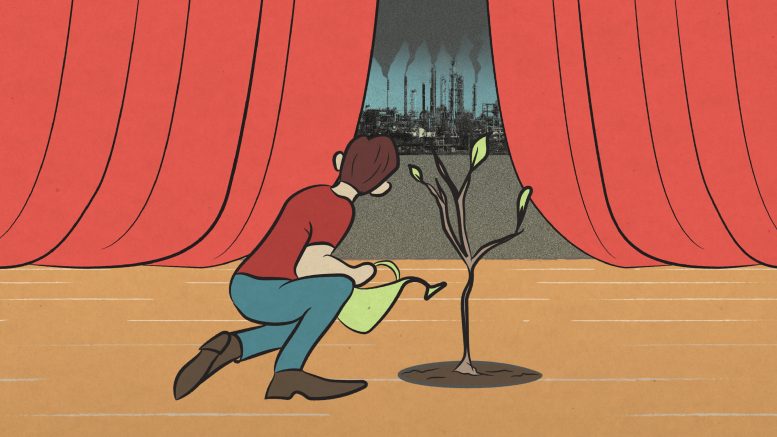Around the world, the majority of people now agree human-caused climate change is happening and that actions need to be taken to address the threat it poses. However, it seems there is less agreement about what actions need to be taken and by whom. One reason for this disagreement, we humbly suggest, is that commercial interests have capitalized on environmental concern to meet their own myopic goals.
A valuable tool for those who seek to blur the lines of necessary action is to obfuscate terms. Today, people confront a variety of terms with distinct meanings under the umbrella of environmental concern daily. Under this umbrella, policies seeking to reduce the amount of plastic in the ocean, fossil fuels used by consumers and the protection of green spaces are all given equal merit. While all of these goals are noble, our current emergency requires us to examine, prioritize and institute specific actions to counter human-caused climate change.
Greenhouse gases and climate change
The abundance of energy that humans currently enjoy has led to the most prosperous era in history. More than ever before, humans can capture and control the fundamental forces in our environment and put them to use to eliminate our burdens. However, energy revolution has also led to disastrous outcomes, including the destabilization of our climate.
Climate change refers to long-term changes in weather patterns and temperatures. Human activities have been the primary driver of these shifts since at least the 1800s. While the earth’s climate has experienced dramatic shifts in its long history, these changes predated the earliest human civilization. The modern climate that humans have experienced began with the end of the last ice age, roughly 11,700 years ago. For perspective, the climate had been relatively stable since before humans practiced agriculture or had developed written languages. That is, until the Industrial Revolution.
Scientific consensus is clear — it is very likely human actions have warmed the atmosphere, ocean and land. Global warming has been observed since the middle of the 20th century. Global warming refers exclusively to heating caused by human activity, while climate change encompasses both anthropogenic and natural forces that cause temperature changes. The terms have often been used interchangeably, but the distinction is important.
The global warming of the past 200 years is largely the result of industrialization. The Industrial Revolution changed the majority of human work away from small-scale manual labour to large-scale machine-driven operations. Many industrialized processes relied on the burning of fuels to generate energy. Gases linked to industrial processes began to be released in the atmosphere in much greater quantities than ever before. These gases trap heat in the atmosphere, a phenomenon known as the greenhouse effect. Gases that contribute to the greenhouse effect are called greenhouse gases and include carbon dioxide, methane, nitrous oxide and water vapour.
Therefore, a reasonable litmus test for climate change policy is to examine the degree to which the policy reduces or eliminates a source of climate-destroying greenhouse gases.
Our current crisis begins with coal. While it has provided many people the energy that our current quality of life is dependent on, it has also caused significant harm to our environment. Just as the coal-fired steam engine propelled the industrial age, so too do fossil fuels in our modern era. Fossil fuels are carbon-rich deposits found deep in the ground and come from the remains of decomposing organic matter. Burning fossil fuels like coal, oil and natural gasses contribute to roughly 80 per cent of the world’s energy supply.
Fossil fuels have two independent and critical flaws which make them impossible to rely on as an infinite source of energy. Each critical flaw is an important element to overcome, but only one perpetuates climate change. First, fossil fuels emit greenhouse gases which are primarily responsible for climate change. Second, fossil fuels are finite resources, which means, at some point, we will run out.
Although there has been some debate regarding when exactly it will happen — unless we are able to produce fossil fuels at a reliable pace within our lives — it will undoubtedly occur. In this way, fossil fuels are not sustainable. It is crucial we switch to a fuel source that emits fewer greenhouse gases.
Renewable fuel sources
Instead of focusing entirely on limiting greenhouse gas emissions, many countries have focused on transitioning to renewable fuel sources. One increasingly popular sustainable alternative to fossil fuels is biomass energy. The phrase “biomass energy” simply refers to the use of biological material as a fuel source. While biomass is sustainable, it is not clean. For example, things like biodiesels or methane derived from decomposition are classified as biomass energy. However, the single largest source of biofuel is wood.
Among countries in the European Union (EU), biomass is the main source of renewable energy and the largest source of biomass fuel used in the EU is forestry.
Burning wood is sustainable and, some argue, carbon-neutral. However, in practice, burning wood can be more carbon-emitting than coal or other conventionally dirty fuel sources. The research is currently contested — the range of emissions sways from 83 per cent less greenhouse gas emissions compared to coal to 73 per cent more greenhouse gas emissions than coal.
In short, considering the greenhouse gas impact of burning wood, it is either nearly as bad as coal or far worse than coal. But at least it can tout its sustainability.
Real-world example
The argument for the sustainability of wood as a fuel source is clear: for every tree cut down, we promise to plant a new one. This means all the carbon emitted into the atmosphere will theoretically be absorbed back into a newly planted tree.
Demand for wood pellets as an energy source has soared since nations signed the Paris Agreement in 2015. Demand is likely to increase as EU countries aim for 32 per cent of energy consumption to come from renewable sources by 2030.
The renewable heat incentive from Northern Ireland in 2011 serves as an egregious example of divorcing climate policy from greenhouse gas emissions and substituting alternative environmental goals. This policy came from the department of enterprise, trade and investment and provided a cash incentive for business owners who used a renewable energy source to heat their buildings.
The plan had one catch: it paid more than it cost business owners in fuel and there was no upper limit to the incentive.
In 2015, applications for the program rose considerably as some business owners allegedly began installing boilers and heating to previously unheated factories. The abuse of this scheme came to light when a whistleblower claimed a farmer anticipated collecting roughly UK£1.5 million over 20 years to heat an empty shed.
Businesses were given an incentive by the government to waste carbon-emitting fuel.
In addition to destabilizing the budget and siphoning taxpayer money to private corporations, the scheme also led to the needless emission of carbon. The biofuel of choice for these boilers were wood pellets, which, as previously stated, may be worse for the environment than coal.
The most fundamental problem with the renewable heat incentive was not an oversight or a miscalculation by the government. Rather, the core of the problem was that it co-opted climate change as a means to introduce policy that was irrelevant to our changing climate. By assessing the impact of the program and working backward, it looks like the goal of the program was to provide a stimulus to businesses.
Projects like this slip past our purview because they seem to pay lip service to environmental concern. In reality, they misunderstand the current crisis and fail to provide a solution.
Moving forward
We can be certain policies that focus on the wrong goals will lead to the wrong outcomes. We need to focus on reducing the amount of greenhouse gas that enters our atmosphere instead of relying on myths of sustainability to recapture carbon. While there has never been more support for effective climate action than there is today, we need to focus on our commitment to effective policy.
The last decade has been the warmest on record. Global warming will continue to bring unprecedented changes to every corner of the earth. The changes we have experienced are the result of about 1.1 C of warming above the levels present in the 1800s. Rising sea levels, caused by glacial melt, threaten not only small island nations but many of the larger, more densely populated coastal cities on the planet. Storms, wildfires, droughts and floods will increase in intensity and frequency. The risks of these climate events depend on the rate, duration and peak warming temperatures we experience.
Carbon emissions need to be prioritized in climate policy to mitigate and reverse the effects of global warming.



